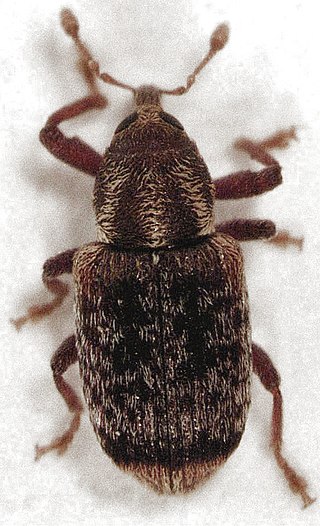
Peristoreus is a weevil genus native to New Zealand. This genus was first described in 1877 by Theodor Franz Wilhelm Kirsch.
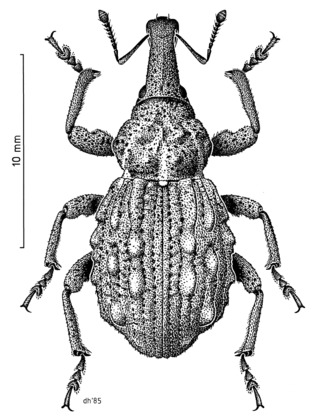
Hadramphus tuberculatus is a rare weevil endemic to Canterbury in the South Island of New Zealand. It was thought to be extinct in 1922 but was rediscovered in 2004.

Mecodema is a genus of large flightless ground beetle (Carabidae) endemic to New Zealand. The genus is very diverse in comparison to the other three New Zealand genera within the subtribe Nothobroscina. Mecodema is geographically widespread across both the North and South Islands, as well as numerous offshore islands, including the Three Kings Is., Poor Knights Is., Aotea and Hauturu, Kapiti Is., Stephens Is., Stewart Is., Chatham Is., Snares Is.

Chaetosomatidae is a small family of beetles, in the superfamily Cleroidea. There are three extant genera, two of which are endemic to New Zealand with the other (Malgassochaetus) native to Madagascar. Members of this family are predaceous on wood-boring insects.
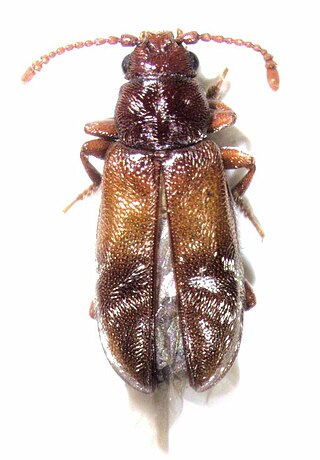
Cavognathidae is a family of beetles, in the superfamily Cucujoidea. It contains a single genus, Taphropiestes with around a dozen species known from South America, Australia and New Zealand. In Australian and New Zealand species adults and larvae have been found living in bird nests, but their ecology is unclear, but they are possibly scavengers.
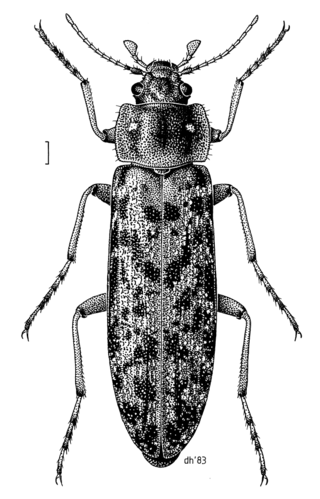
The Chalcodryidae are a family of beetles in the superfamily Tenebrionoidea. It contains at least five species in two genera Chalcodrya and Philpottia, which are endemic to New Zealand. They are generally found associated with moss or lichen covered branches, with the larvae having been found to be associated with dead twigs. They are likely noctural, feeding on lichen and other plant material at night. The genera Sirrhas and Onysius, formerly placed in this family, have subsequently been transferred to Promecheilidae.

Thomas Broun was a Scottish-born soldier, farmer, teacher and entomologist, who spent much of his career in New Zealand. He is known for his study of the beetles (Coleoptera) of New Zealand.

Holcaspis is a genus of beetles in the family Carabidae, endemic to New Zealand.

Mitophyllus is a genus of large stag beetles endemic to New Zealand.

Peristoreus flavitarsis is a species of true weevil. It is endemic to New Zealand. The larvae are leaf miners of Podocarpus totara. Similar leaf mines have also been found on Podocarpus acutifolius and Podocarpus cunninghamii.
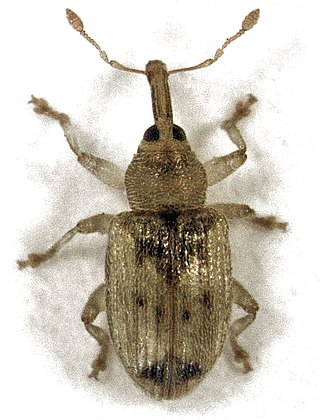
Peristoreus stramineus is a species of true weevil. It is endemic to New Zealand. The larvae develop in flower buds of Hoheria populnea.
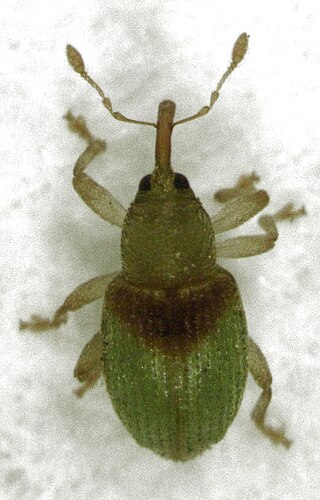
Peristoreus viridipennis is a species of true weevil. It is endemic to New Zealand. It is associated with plants of the genus Muehlenbeckia.

Eumolpini is a tribe of leaf beetles in the subfamily Eumolpinae. It is the largest tribe in the subfamily, with approximately 170 genera found worldwide. Members of the tribe almost always have a longitudinal median groove on the pygidium, which possibly helps to keep the elytra locked at rest. They also generally have a subglabrous body, as well as appendiculate pretarsal claws.
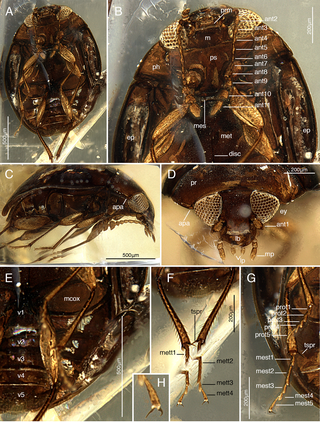
Cyclaxyridae are a family of beetles in the superfamily Cucujoidea. The only living genus is Cyclaxyra, with two species endemic to New Zealand. Other species have been named from fossils. They are also known as sooty mould beetles due to the association of Cyclaxyra with sooty mould. The extant species are mycophagous, feeding on spores, conidia, and hyphae.
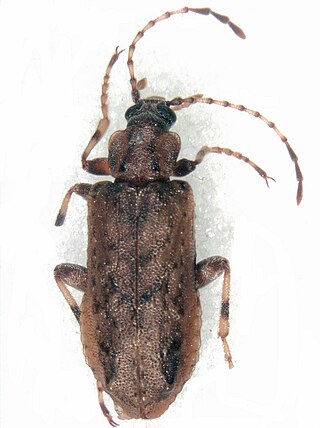
Promecheilidae is a family of beetles in the superfamily Tenebrionoidea. Perimylopidae is considered a synonym. They are found in southern South America and associated archipelagos like South Georgia and the Falklands, New Zealand and Tasmania. Some species are associated tree ferns and moss-covered dead wood, and other forested habitats, while others are associated with peat bogs, grasslands and coastal habitats. They are probably phytophagus, feeding on lichen, moss, and other plant material.

Eucolaspis is a genus of leaf beetles in the subfamily Eumolpinae. It is native to New Zealand, where it is a serious pest of apple trees and other fruit crops. The genus has also been reported from Fiji.

Paralissotes is a genus of stag beetle that is endemic to New Zealand.

Brachyolus is a genus of broad-nosed weevil in the family Curculionidae.

Hoherius meinertzhageni, the ribbonwood fungus weevil, is an endemic New Zealand beetle that has been recorded feeding on the ribbonwood species Plagianthus regius and Plagianthus divaricatus and the mountain lacebark, Hoheria glabrata.

Exorides is a genus of broad-nosed weevils in the family Curculionidae, tribe Eustylini, distributed in northern South America.



















